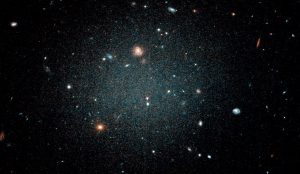 This image of NGC1052-DF2 was taken by the Advanced Camera for Surveys on the Hubble Space Telescope. (Photo credit: NASA, ESA, and P. van Dokkum [Yale University])
This image of NGC1052-DF2 was taken by the Advanced Camera for Surveys on the Hubble Space Telescope. (Photo credit: NASA, ESA, and P. van Dokkum [Yale University])
In a paper published in Nature last week, researchers from Yale, San Jose State University, University of Toronto, Harvard, and the Max Planck Institute for Astronomy revealed a startling discovery: they have found a faint galaxy that contains no dark matter. This discovery is startling and important because it establishes for the first time that “dark” matter, making up about 85% of the mass in the universe and so called because of its lack of interaction with light, is not necessarily present in every galaxy as previously thought. This demonstrates that dark matter is a substance that exists independently and is not merely an artefact of gravity in galaxies. The discovery further requires that new theories be developed for how to form galaxies without dark matter as a gravitational incubator.
SJSU Physics and Astronomy Professor Aaron Romanowsky, a co-author of the paper, and his colleagues were able to demonstrate the absence of dark matter in the galaxy, known as NGC1052-DF2, by analyzing the velocities of star clusters orbiting the galaxy from spectroscopic observations made at the W. M. Keck Observatory on Mauna Kea, Hawaii. From the velocity distribution they measured the mass in the galaxy and thereby ruled out the presence of significant amounts of dark matter.
Another account of this groundbreaking work can be found from the Hubble Space Telescope.